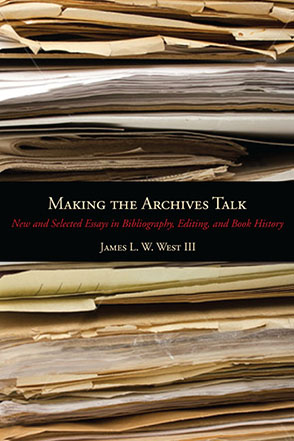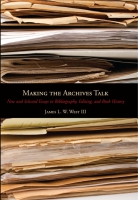
Making the Archives Talk
New and Selected Essays in Bibliography, Editing, and Book History
James L. W. West III
Making the Archives Talk
New and Selected Essays in Bibliography, Editing, and Book History
James L. W. West III
“This collection of essays is enthralling to read for many reasons: the author’s unique perspective on book history, his insight into the field of scholarly editing, and, especially, a scholar’s detailed use of archival collections.”
- Description
- Reviews
- Bio
- Table of Contents
- Sample Chapters
- Subjects
“This collection of essays is enthralling to read for many reasons: the author’s unique perspective on book history, his insight into the field of scholarly editing, and, especially, a scholar’s detailed use of archival collections.”
“Jim West’s stories about, and his reflections on, his many years editing the works of such major literary writers as Fitzgerald and Styron are told in a humane, reflective, and pragmatic spirit. West brings intriguing evidence to bear. He shows how the Realpolitik of the book trade, the technical concerns of bibliography, and the crises of cultural politics crisscross the editorial arena, complicating the whole endeavor. This engaging book is a narrative capstone to a distinguished career in scholarly editing and book history.”
“For many years Jim West has shown that editing literary works is an intensely critical and humane activity that engages the full range of an editor’s learning and abilities. The ten previously published essays selected for this volume have been significantly revised so that this book is the single most authoritative reference for these works. . . . Even those who have participated in his luminous career will be eager to read the two new essays. He is one of very few biblio-textual writers whose works are ‘a good read.’”
“James West is one of our most accomplished editors and critics. This welcome new collection of essays on modernist prose writers shows him at his best, weaving expertly between general principles and particular texts by Dreiser, Fitzgerald, Styron, and others. A leading intentionalist scholar, West brings a lifetime’s knowledge to bear on important works and on the process of constructing them.”
James L. W. West III is Edwin Erle Sparks Professor of English at The Pennsylvania State University and general editor of Penn State Studies in the History of the Book. He has published some twenty scholarly editions—among them editions of Theodore Dreiser’s Sister Carrie and Jennie Gerhardt; F. Scott Fitzgerald’s This Side of Paradise and Trimalchio; and William Styron’s Inheritance of Night and Letters to My Father. West’s books include American Authors and the Literary Marketplace Since 1900 (1988), William Styron: A Life (1998), and The Perfect Hour: The Romance of F. Scott Fitzgerald and Ginevra King (2005). He has been awarded fellowships and grants from the J. S. Guggenheim Foundation, the National Humanities Center, the American Philosophical Society, the National Endowment for the Humanities, and the American Academy in Rome. West has held Fulbright appointments in England at Cambridge University and in Belgium at the Université de Liège.
Contents
List of Illustrations
Introduction
1 The Scholarly Editor as Biographer
2 Editorial Theory and the Act of Submission
3 Fair Copy, Authorial Intention, and Versioning
4 Alcohol and Drinking in Sister Carrie
5 Double Quotes and Double Meanings in Jennie Gerhardt
6 Editing Private Papers: Three Examples from Dreiser
7 Toxic Words and the Editor
8 Did F. Scott Fitzgerald Have the Right Publisher?
9 The Internal Chronology of Tender Is the Night
10 Annotating Mr. Fitzgerald
11 Keeper of the Flame: Editing the Literary Remains of William Styron
12 The End Is Near
Acknowledgments
Index
Introduction
Good editors are good narrators. In constructing their editions they tell two stories. The primary narrative gives an account of how the literary work came into being; the secondary narrative tells how the editor gathered the evidence, evaluated it, and established the text. Both narratives are essential to the success of the edition.
The primary narrative tells how the work was conceived, composed, revised, and polished; how it was submitted to publishers, accepted for print, and put into production; how it moved through the publication process, with further revision and refinement and sometimes with cutting and bowdlerization; and how it was released as a published artifact. Many of these primary narratives are stories about overcoming obstacles to arrive at goals, achievements, victories. The best narratives include drama and suspense. The author—whether young and apprehensive, middle-aged and experienced, or old and weary—can face an array of challenges. These typically include lack of money, poor health, doubts about the material, difficulties in love, flagging confidence, and personal demons such as alcoholism and mental illness. The challenges are met: the result is a literary work of merit, created for an audience which the author can only imagine during the act of composition. This audience materializes soon or late and gives way to other audiences of readers, teachers, and critics who hold the work in high esteem. The author persevered during the original period of creation. The work was finished and published; it ascended into the canon; decades later it is still read and studied. A scholarly edition of this work is now needed.
In order to write such a narrative, an editor must “make the archives talk”—hence the title of this collection. The editor must examine the surviving notes, manuscripts, typescripts, proofs, and other evidence. The editor must also read the relevant letters and journals and study the publishers’ records and account books. From these materials an account of the composition of the work can be fashioned. The narrative will be assembled from evidence that is otherwise inert. One does not “allow” the archives to talk; one “makes” them talk, crafting stories in the same way that biographers and historians do, by selecting and arranging the evidence and writing a story that ties the whole together.
The secondary narrative is equally important. It follows naturally from the primary narrative, running beneath and parallel to it. The secondary narrative is often a “quest” story—the editor’s account of gathering and evaluating materials, searching for error or interference, and presenting the text in a new form. The editor has devoted much time to the task, locating documents and fugitive materials and comparing incarnations of the work to one another in order to arrive at a different text—this in service of the author, the reader, and literature. This secondary narrative (though not written with the pronoun I) is presented in the editor’s voice.
Both narratives are fabrications, constructed from documents and other testimony at hand, often fragmentary or incomplete, and including both facts and imagined reconstructions. Editorial narratives are shaped by selection, emphasis, and vocabulary. They can confirm the soundness of the received text or call for a different text. Frequently the evidence can be made to support either argument.
Several of the essays in this volume are narratives of this kind, intended to validate an editorial approach to a particular text. The first three essays are abstract and theoretical; most of the others involve the editing and annotation of specific texts. I have drawn on some forty years of experience for my examples. The authors whose works I have edited during my career are Theodore Dreiser, F. Scott Fitzgerald, and William Styron—all twentieth-century American writers best known for their novels, short stories, and nonfiction. The problems found in their texts and the availability of extensive collections of their papers have shaped my view of scholarly editing. These are not obscure authors: their writings have been widely read and praised. Their books sold well during their careers and continue to sell today—a fact of which I have been conscious while editing. Dreiser, Fitzgerald, and Styron have thousands of contemporary readers, not only in the academy but also among the laity. I have wanted to produce editions that would appeal to these readers and be useful to them.
I am an intentionalist editor. I believe that authors have intentions for their writings, that these intentions change over time, and that particular sets of intentions can be recaptured, though never fully or perfectly. The best method of recapture is eclectic emendation, which brings together readings from several witnesses or versions (when they survive) to form a new text. This text will be as close to the desired ideal as scholarly labor and imaginative reconstruction can bring it.
Classic Greg-Bowers copy-text procedures, usually associated with intentionalist editing, are not well suited to the editing of twentieth-century works, especially if manuscripts, typescripts, and proofs are extant. But intentionalist editing and the creation of eclectic texts, with readings drawn from more than one witness, can be executed without copy-text procedures. Editing without a copy-text, in fact, frees the editor from the tyranny of such a document and makes it easier to regard the text as fluid and unsettled.1 One eclectic text can be created and published from among many that are possible. Other editors, interpreting the same evidence in different ways, can create and publish their own texts, once the work has passed into the public domain.
The editorial theorists who have most strongly influenced my practice, without necessarily agreeing with all of my views, are G. Thomas Tanselle, Peter Shillingsburg, George Bornstein, and Paul Eggert. Tanselle’s insights about authorial intention and copy-text editing have been illuminating; Shillingsburg’s flexibility and openness to new thinking have been exemplary; Bornstein’s emphasis on the original sites of publication has been educative; Eggert’s restoration of authorial agency and his inclusion of the editor, from the beginning, in the history of the text have been liberating.2
I have not been persuaded by the writings of editorial theorists who want to see all texts as socially constructed and therefore inviolable.3 Texts are certainly shaped by the circumstances of their making and publication, but it does not follow that they cannot be significantly emended with readings from other witnesses, unless the purpose of literary interpretation is to duplicate the reactions of original readers to original texts—an impossible task. Most of these theorists eschew eclectic editing; they use instead an approach that is sometimes called “versioning.”4 In its essentials, this is historical or documentary editing, with the editor’s role largely confined to transcribing, annotating, and (in a limited way) interpreting. The role of the author is diminished and sometimes subordinated to the activities of spouses, friends, amanuenses, typists, publishers, copyeditors, book designers, typesetters, and proofreaders. The moral stance of the editor—his or her sense of putting things to rights—is likewise diminished.
The labor required to produce a versionist or historical edition is almost the same as that needed for an eclectic edition, but the text presented is a preexisting one, lightly emended or not emended at all. To me this avoids the responsibility and great pleasure of scholarly editing—to repair an old text or put into play a new one. This new text will itself have been socially constructed, as will the two editorial narratives. The process of social construction for the new text will have been superior to, or certainly different from, the process that produced the old text. The new text will need interpretation. The process will continue; it cannot be arrested or frozen in time.
Versionist or historical editors are often hobbled by theory and paralyzed by overanalysis. Their procedures undercut both the primary and secondary editorial narratives. The author becomes only one among many actors; the editor becomes primarily a copyist and annotator. Almost the only possible errors that an editor of this persuasion can make are those of transcription or reproduction. Little is attempted: the evidence is presented neutrally to an imagined audience of readers and critics who are invited to evaluate and react to it. This audience, however, seems rarely to emerge. One does not often see ponderings on variant passages in the pages of scholarly journals or hear debates about the superiority of this reading over that reading at academic conferences. Most rank-and-file critics and teachers of literature have not been trained to use scholarly editions and are not especially interested in learning how to do so. Versionist editing validates the inertia of this group. Misoneism, or resistance to change, is endemic among humanists and dovetails with versionist editing. Scholarly editors are left open to a familiar charge—that what they do does not matter and is little more than sophisticated secretarial work.
Social constructionists have had the good effect of ridding the field of much hubris and overstatement. It is no longer acceptable to refer to a text as “definitive” or, except in the simplest of cases, to claim that a text will never need to be edited again. Versioning and historical editing function well for short works of poetry and for stories and essays that survive in unique texts or discrete versions. (In such cases, of course, there is little question about how the texts will be edited.) I have used versionist techniques, most notably on Fitzgerald’s short novel Trimalchio, the penultimate version of The Great Gatsby. For most of the texts I have edited, however, I have sought to recapture authorial intentions by using eclectic techniques. For me historical or versionist editing is overly mechanical and defensive, placing too great a value on consistency. Intentionalist editing, by contrast, takes an offensive stance. It is a human enterprise, therefore imperfect and inevitably inconsistent.
The age of digital texts has arrived and promises much to scholarly editors. It is possible already to present multiple texts, corrected or not, emended or not, blended or not, using eclectic techniques or historical methods or both simultaneously. The next generation of scholarly editors will work (perhaps altogether) in a digital environment. But if digital editions become nothing more than collection points at which to store archival evidence in the hope that someone will use it, then we will not have advanced. I have worked always in paper and ink; I seek the permanence of a printed text. With a text fixed in paper and ink, an editor can be wrong. An editor can also be right. Editors, in my view, should interpret evidence, fashion narratives, make decisions, and take chances. They should see their decisions into print and accept responsibility for them.
Competition among editorial approaches will continue. The shuttlecock, in Dr. Johnson’s formulation, will be struck on both sides of the net and thus be kept aloft. Disagreements will persist; new editions will appear. Two hundred years from now a young editor will use my work on Fitzgerald as the basis for the first old-spelling edition of The Great Gatsby. Editing abides. I take comfort in that.
Mailing List
Subscribe to our mailing list and be notified about new titles, journals and catalogs.



